AUSTRALIAN WINES
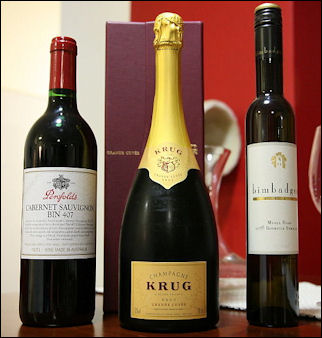
Australia Champagne Krug Penfolds
and Bimbadgen wines Australians consumed 20 liters of wine in 1999, up from 15 liters in 1979 and only 8 liters in 1969. Australian drink more white wine than red wine before 2000 but now consume red and white wines in equal measure. Reds have become popular because Australia produces first rate reds and more people began taking to heart the reports that drinking red wine improves one's health.
Grapes have been cultivated in Australia since 1788. The first Australian wine makers were English gentry who took it up soon after the colony was founded late 18th century. The Barossa Valley, Australia's most famous wine making region, was settle in the mid-1800s by Silesians from Poland and the Czech Republic who brought their wine-making skills with them from their homeland.
Early Australian wines were largely scoffed at because many of them turned on the long ship journey to Europe. Wines began to improve with the irrigation of hot, dry land and the invention of refrigerated ships. The wine industry began to take off in the late 1970s, led by its port and muscat makers. The wine market initially grew based on the export market. Then as Australians became more affluent domestic consumption of wine increased, spurring further growth.
Websites and Resources: Guardian & Observer Guide to Wine guardian.co.uk/lifeandstyle/page ; Wine Anorak wineanorak.com ; Wine Spectator winespectator.com ; Wine.com wine.com ; Wikipedia article Wikipedia ; Tesco Wine tesco.com/wine ; Wine Types wineintro.com/types/ ; Types of Wineslovetoknow.com/wiki/Category:Types_of_Wine ; Types of Wine Grapes frenchscout.com/types-of-wines ; History of Wine winepros.org/wine101/history ; Wikipedia article on History of Wine Wikipedia ; History of Wine Cornell University /rmc.library.cornell.edu/ewga/exhibition ; Winemaking wineintro.com/making ; Wine Producing madehow.com
Australian Wine Production

Australian Wine in a Can The main Australian wine show features 8,000 wines from 350 wineries from 42 different winemaking regions. Most of Australia's best wines are reds made from shiraz and Cabernet Sauvignon grapes. White wines are new phenomena. They are produced primarily with Riesling or sémillon, Sauvignon blanc and Chardonnay grapes.
Australia's wine industry is centered in the Barossa Valley, an unspoiled bucolic area originally settled by German immigrants. It is in the state of South Australia, 45 miles northeast of Adelaide. The middle slopes of the Adelaide Hills are the source of the grapes for many of Australia's premier wines. Harvesting takes place between February and May.
Although an astonishing number of good wines are produced in Australia, winemakers are still experimenting to figure out which grapes grow best in which region. Like California wines, the word is still not out on how Australian wines will hold up over time.
Southcorp wines is Australia's largest wine maker. It exports more top-end red and white table wines (excluding bulk wines, champagne and fortified wines) than any other company in the world. It exported 5.5 million cases in 1998, including 2.5 million cases to Britain and 1.5 million cases to the United States. It sales roughly doubled between 1993 and 1996 and exports make up more than 40 percent of the company's total sales.
Australia?s Premium Wine Producers

Hand harvesting Pinot noir
grapes in Australia While premium wines from France and other places are often produced at small wineries with long histories and traditions this is not the case in Australia. Grange, Yattarna and other quality wines are produced in a highly mechanized factory run by Penfolds in the town of Nurrioopta in the Barossa Valley. Penfolds is owned by Southcorp. [Source: R.W. Apple Jr. New York Times, October 13, 1999]
R.W. Apple Jr. wrote in the New York Times, "With wine tanks the size of silos, miles of tubing and more than a dozen low-lying buildings, the Penfolds operation looks more like an oil refinery than a winery...One bunker-like, air-conditioned concrete structure covers five acres... All the upper-end Penfolds red wines, including Grange, are in this building, by far the largest of its kind in the world."
A Penfolds winemaker told the New York Times, "No lovely mythical winery here. Here it's all production, all the time." Penfolds produces between 7,000 and 12,000 cases of Grange and 2,000 cases of Yattarna each year.
Premium Australian Red Wines
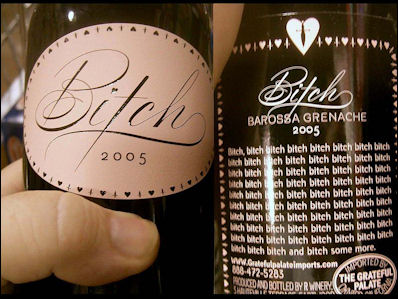
Bitch Barossa Grenache
Australian red wines, especially Grange and Hill of Grace red wines made with peppery shiraz grapes, once dismissed are now regarded as among the best in world. The influential magazine, Wine Spectator, rated Australia's Penfolds Grange 1990 as the world's best wine in 1995. It was the first time of wine from outside France and California had been so honored. Eight other Australian wines were in the magazine's top 100 for 1995. In 1996, there were 16 wines in the top 100 — the same as France.
Australia wines have developed such a reputation that foreign buyers and connoisseurs are purchasing Australian wines as investments. Bottles of Penfolds Grange 1990, which originally sold for $120, now are auctioned off for $400 or $500.
Other great Penfolds reds include pure cabernets like Bin 707 and pure shirazs like Kalimna Bin 28, which have received almost as many awards as the as the Grange. Charles Melton produces a first rate blends of shiraz, aromatic mourvédre and fruity grenach wines called Nine Popes.
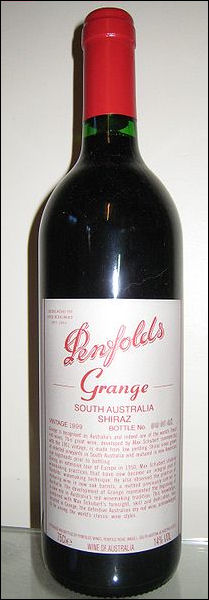
Penfolds Grange Australia's most praised white wine is Yattarna, named at the Aboriginal word meaning "little by little." It was produced by the winery Penfolds as part of a $1 million, six-year project. The first vintage, a 1995 first sold in 1999, caused a stir at the Sydney Wine Show. People camped out overnight to try it. The second vintage was even better. Describing a Yattarna white, R.W. Apple wrote in the New York Times, "Yattarna has been built to last, in a balanced style, creamy but not over oaky, with a luscious, lingering finish and a nice nip of citrus at the end."
The family-owned Henschke Cellars produces a shiraz called Hill of Grace that many say is good as the Grange. Unlike Granges, which are a blend of wines, Hill of Grace wines are made from wine form a single winery, which means its more likely to have good years and bad years. A 1980 Hill of Grace costs around $215 a bottle at restaurants, slightly more than a 1980 Grange, which sells for about $200.
Grange Wines
Australia's famous Grange wines were created by Max Shubert, a winemaking legend who died in 1994. Apple wrote, "Deeply impressed by the first growth of Bordeaux, Mr Shubert emulated many French practices, including the use of new oak for aging, in attempting to create an Australian counterpart. Lacking sufficient Cabernet Sauvignon when he began in 1951, he used mostly shiraz.
Shubert worked at the Penfolds vineyard. His first wines were greeted with so little enthusiasm he was told to stop making them. After deciding that he released his wine to early, before it had “come together," he continued making wines in secret.
Eventually Shubert succeeded in creating wines with a world class reputation made from the best grapes grown in cool climates across Australia. Apple wrote, "possibly the richest, most concentrated wine on earth, it is still made mostly from the fruit of low-yielding old vines, grown with irrigation.”
The famous Grange 1990 is a blended red wine made almost entirely of shiraz grapes through careful bleeding in a consistent "house style." Connoisseurs have said it tastes of "raspberries, strawberries, violets, truffles and old boots." Other great Grange vintages include a 1976 and 1986.
Most of the grapes used in Grange wines come form the Penfolds-owned Ralimna vineyard, about three miles northwest of Nurioopta. One winemaker told the New York Times, this "is where most of the oomph in the wine come s from." Other grapes come from contract growers who receive generous bonuses for producing first rate grapes.
Jacob's Creek and Other Top-Selling Australian Wines

Among the Australian wines that sell well overseas are Lindermans, Black Opel, Jacob's Creek, Penfolds, Rosemount Estates, Yalumba, Wyndum Estate, Black Marlin, Oxford Landing and Peter Lehmann.
The best selling wines in the $6 to $20 range are Jacob's Creek, Lin 65 Lindemnas, Wirra Wirra and St. Hallet; the $20 to $35 category are led by Petaluma and Heinschke; the super premiums include Penfolds Bin 707 and the Granges.
Jacob's Creek is perhaps's the most well known name in Australian wine. Sold in more than 50 countries, Jacob's Creek is the most popular Australian wine in Britain, Ireland, Scandinavia, Asia and New Zealand. It is named after a stream that flows through the Barossa valley in South Australia.
In 1848 a Bavarian immigrant,Johann Gramp, planted the first commercial vineyard on the banks of Jacob’s Creek. In 1877 the winery was moved to the current vineyard, which is called Orlando, by Gramps eldest son Gustav. The winery prospered and G. Gramp and Sons Ltd. was founded in 1912. Jacobs Creek wines are made of blends of wines from Australia's best viticultural districts. The brand was was first marketed in 1976. The first wine sold was a 1973 red wine. The goal of the company has been to produce smooth, flavorful wines that are an excellent value for the money and don't require a long time to age.
Jacobs Creek wines have won a number of awards. In 1994, the winery won the Australian Wine Industry's coveted Maurice O'Shea Award for outstanding contribution to the Australian wine industry. Also in 1994, Jacob's Creek Chardonet won a Gold Medal and Diplomat of Honor at the Challenge International Du Vin in Blatbourg Bordeaux. In 1997 alone Jacob's Creek won two trophies, 13 gold, 34 silver and 81 bronze medals in domestic and international wine shows.
Australia’s Aggressive Wine Selling Strategy
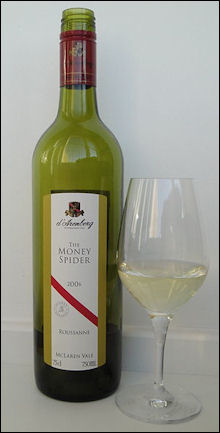
Money Spider Roussanne 2006 Australian wines are sold in 80 countries. The industry came alive in the 1990s. Exports leaped 35 percent to a record $418 million in 1996. A decade before wine exports added up to only $45 million. In 1996, Australia accounted for 4 percent of the world wine exports (up from 2 percent in 1991).
Leading markets of Australia wine (1997): Britain (45 percent); the United States (19 percent); New Zealand (7 percent); Canada (5 percent); other (24 percent). Australian wines are a major presence in British supermarkets and are common in Japan.
Australia’s wine industry hopes to become the "world's most influential and profitable supplier of branded wines” in the year 2025 by raising exports to $2.5 billion and increasing domestic consumption from $1.15 billion in 1996 to 2 billion in 2025.
“Without drama, flair and gimmicks but working the markets carefully," American wine analyst Greg Godels told the New York Times, “Aussie wines have done a very good job. They've petered out in the past, but this time they have got better packaging, better quality and seem to have really researched the market. They're making the kinds of wines California used to make, a lot of oak — Americans like the oak."
Among wine consumers Australia has a reputation for producing great value-for-money wines and a select group of premier wines. Factors that have contributed to the success of Australia's wine industry include an ideal climate for growing a wide variety of grapes, relatively cheap land and production costs and innovative viticulture and wine-making methods. Wine lecturer Larry Lockspin told the New York Times, "The secret has been the willingness to adapt to the buyer. So you want a little less oak, more fruit. Fine, we'll give it to you." Australia 26 percent wholesale tax on wine and national thirst for beer are offered as reasons why Australia wines perform better abroad than at home.
Chilean Wine
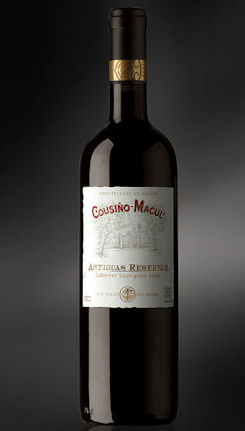
Chilean Antiguas reservas wine Chile produces wine under many different labels. Concho y Toros is probably the most well known brand. The best Chilean wines are grown in the Central Valley. Wine grapes are also grown south of the Central valley in the valleys and slopes of the coastal mountains in the Maule and Bio Bio regions.
Much of Chile’s wine is exported to bring in foreign currency. Countries that exported the most wine to the United States in 1996: 1) France; 2) Italy; 3) Chile; 4) Australia; 5) Spain; 6) Portugal; 7) Germany. Concho y Toros is the second largest supplier of wine in the United States after Italy's Reuinite.
Americans like Chilean wines because its cheap, pretty good and a good value for the money, with prices starting at around $5.00 a bottle. An effort in 1993 to generate more revenues by increasing the cost of the wine proved to be disastrous. Wine sales dropped by 10 percent after increasing by as much as 20 percent in previous years.
Chile exports three times much as wine as Brazil, the next largest Latin American exporter. Exports of Chilean wine increased from $10.4 million in 1985 to $181.7 million in 1995.
Chilean drink consume relatively little wine themselves and are drinking less all the time. In 1970, the per capita wine consumption rate was 50 liters per person. By the 1990s it had shrunk to around 20 liters. The decline has mainly been the result of efforts by breweries to turn Chileans into beer drinkers.
Short History of Wine in Chile

Chilean Carmenere Since wine is a necessary component of the Catholic liturgy, the first Europeans to make wine in Latin America were monks. The climate of the central part of Chile proved be better suited for raising wine grapes than almost any other place in the Americas. By the 18th century Chile was the main exporter of wine in Latin America.
The Chilean landholding elite have traditionally been great admirers of France. They imported Cabernet Sauvignon, Merlot, Pinor Noir, Sauvignon Blanc,Chardonnay Semillon vines from Bordeaux and Burgundy as well as Riesling and Gewurztraminer vines from Germany. New immigrants from Spain, Germany and France also brought their treasured grape cuttings with them.
The phylloxera crisis that struck Europe in 1870 was a boon for Chile. It opened up new markets for Chilean wine and brought French winemakers in need of work to Chile.
Why Chile Has Good Wines
The best wines are often grown in dry climates with extremes temperatures shifts during the peak growing times. These conditions are found in Chile’s Central Valley, a strip of land next to the Coastal Mountain range, which has a long, dry growing season, cool nights and periodic blasts of cold Andean air.
The combination of intense photosynthetic activity during the day and nocturnal rest brought by the abrupt temperature changes produces grapes with a color and aroma ideal for wine making.
The long dry summers and the geographical isolation created by its mountains and deserts has meant the Chile vineyards have remainedd relatively immune from attacks by disease and insects. Mildew, for example, is virtually non existent when grapes arrive for the wine making stage.
Argentine and South African Wines
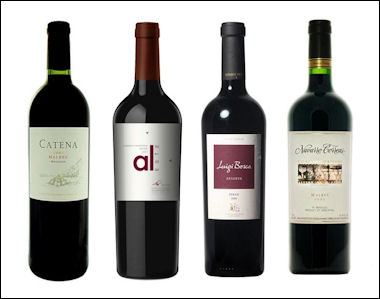
Argentine premium wines Argentina is another large wine-growing country. At one time Argentina consumed 95 percent of its own wine and once held the claim as the largest producer in the world. Argentina large wine production as a result of its fertile soil, good irrigation and dry climate. Most of the wines are bulk table wines even though Argentines vintners are trying to create higher quality wines.
The top 5 wine making counties (tons per year): 1) France (6,200,000); 2) Italy (6,000,000); 3) Spain (3,107,000); 4) Argentina (2,100,000); 5) USA (1,580,000).
Argentines drink most of its domestically produced wine. On average each Argentine drinks about 60 liters a year. In the summer many Argentines drink white wine sangria (“clérico” ), or mix their wine with soda or mineral water. A methanol adulteration scandal in 1993 drastically hurt the Argentine wine export business.
The Mendoza area is famous for wine. It the first vines were brought by Italian and Spanish immigrants. The Bodega de Arizú and Gioll Winery are two of the largest wineries in the world. One blending tank in Mendoza holds 1,300,000 gallons of wine. Tasty Mendoza wines include Cruz del Sur from Bodega Arizú, Cuesta de parsal, Valroy-Borgoña, Valroy-Caberent Sauvingnon, Viejo Toro and Vino de mesa Arizú Tinto Seco.
The Capetown area of South Africa is known for its excellent wines. Dutch colonist Jan van Riebeeck planted the first grape vines on the Cape. In his diary on February 2, 1659 he wrote: "Today — God be praised — wine pressed for the first time from Cape grapes...truly fine bouquet and taste." The wine industry was also helped by the planting of hundreds of cuttings brought in the 17th and 18th centuries by French Huggenots.
Groot Constantia, the oldest wine-making center in South Africa, is now a state-owned experimental wine farm with a museum housed in a homestead estate granted to a Dutch governer in 1685. The Cape Wine Route is located around a group of towns, about 30 miles east of Cape Town. Nestled below impressive, rocky, often snow-capped mountains and surrounded by a patchwork of vineyards and fruit orchards, these towns are famous for the old world architecture. Founded in 1676, Stellenbosch is the wine region's most well known settlement and South Africa's second oldest town. Fransschloek was settled by French Hugenots in the 1680s. Paarl has vineyards within it town limits. And Boschendal has what some argue is the most beautiful winery in the cape area.
Image Sources: Wikimedia Commons
Text Sources: National Geographic, New York Times, Washington Post, Los Angeles Times, Smithsonian magazine, Natural History magazine, Discover magazine, Times of London, The New Yorker, Time, Newsweek, Reuters, AP, AFP, Lonely Planet Guides, Compton’s Encyclopedia and various books and other publications.
Last updated March 2011
